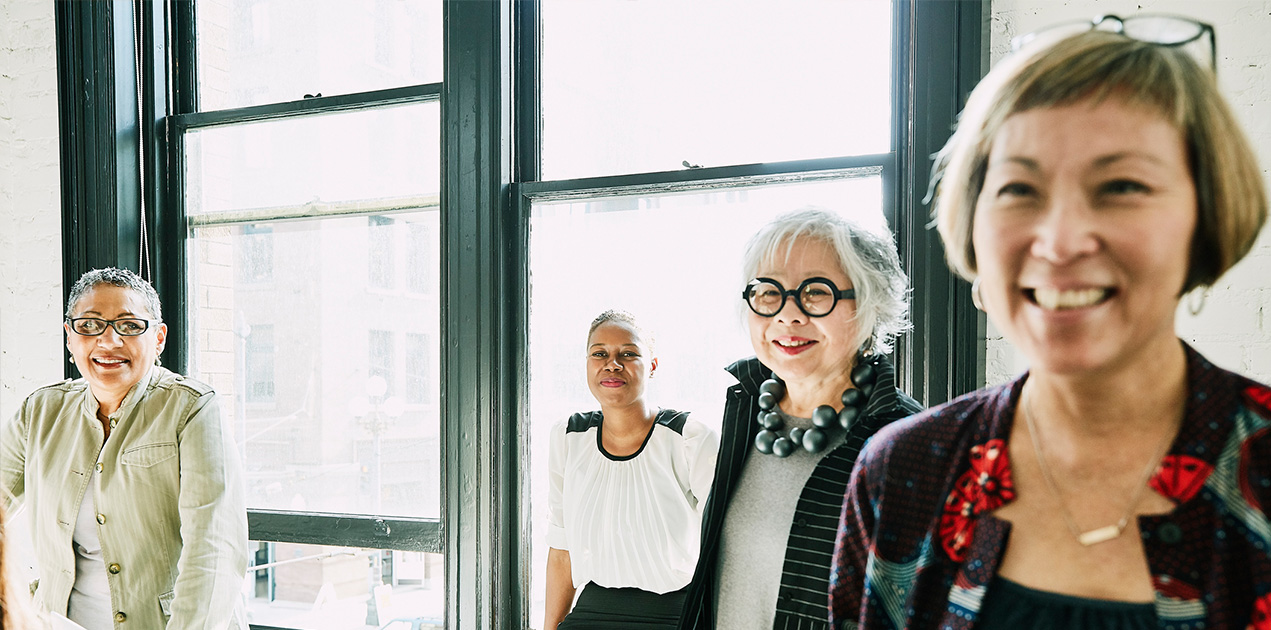After the callous murder of George Floyd by a police officer in May 2020, many organizations committed to new racial equity programs and initiatives. While some have found a measure of success,1 many have been rightly criticized2 for being too timid, lacking accountability, or being only performative.
What needs to be done to create workplaces where employees from marginalized racial and ethnic groups are fully included?
We interviewed 21 business professionals and academic scholars from around the world whose work focuses on race, ethnicity, and culture to hear their unique insights on this question. We asked them to share their stories of what the workplace looks like through their eyes and what they think should be done to create workplaces free from racism and bias.
Their candid and eye-opening stories from across the globe are reminders that racism persists in almost every environment—and that demonstrating empathy and having potentially difficult conversations are essential to making progress at both the individual and organizational levels.
Reading these stories of racism and learning is painful because they bring to light inequities in the global workplace. And when we take care to approach the stories with an intersectional lens, we see that the stories about people from ethnically or racially marginalized groups are about women, men, immigrants, refugees, religious minorities, and Indigenous people.
Taken together, they are inspiring—and necessary. They may be exactly what you need to spark real change at your organization.

Racism Persists
Around the World
To some, racism may seem like a thing of the past, but it’s still very common regardless of where you may live.3 The raw stories told by the experts we interviewed illustrate how they experience, witness, and research racism in their parts of the world. They self-identify as various different genders, races, and ethnicities, and through their many voices and expertise we can hear a chorus of lived experiences shaped by assumptions, stereotypes, and structural inequities.
“Racism is endemic.”
Leo, an Australian researcher of gender, race, ethnicity, and culture, speaks of the deeply ingrained racism that exists in Australia. While his comment is about one specific place, his insights could apply to many other countries and regions.
The other burden that I see that we’ve been studying in our research is [the issue of] being tolerated. So this has to do with situations where people aren’t necessarily feeling negatively about your group, but they disapprove… of specific beliefs or practices of your group… Where ‘I disapprove of the US government’s actions’ or ‘I disapprove of these Muslim cultural practices.’ And as a member of the group, you’re reminded that ‘it’s not that I dislike you all as people, but I disapprove of these specific things about your culture,’ which is… problematic when again, an individual from the group feels that other people don’t accept them fully. Instead, they… hold them responsible for their entire group.
…I think even in a country like New Zealand, that can seem open-minded, in some ways there’s a tolerance towards immigrants where there’s a begrudging acceptance. ‘We put up with you because you serve a functional purpose for us, but we may change our mind.’ Which can make people… who don’t have the national status feel like their position is consistently precarious.”
“We put up with you.”
Dev, a researcher of Southeast Asian descent living and working in New Zealand, explains how tolerance in the context of country culture and government policy is not the same as acceptance—which leads to experiences of exclusion for ethnically marginalized groups.
“Treatment here in Brazil for the Black people is terrible, terrible.”
Noam has worked in human resources and marketing in numerous countries. Currently, Noam works in communications, as well as diversity and inclusion, in Brazil. Noam describes the general treatment of Black people in the workplace in Brazil.
“I know that it’s racist here.”
Dana has worked in the corporate sector in the United States and is now CEO of her own consulting firm. As a Black woman, she experienced charged situations with her White colleagues involving decision-making. Dana candidly shares her observations of how they fester.
Dana also shares a painful instance of racism she faced in the event industry.

Emotional Tax
Takes a Toll
Previous Catalyst research reveals that many Asian, Black, Latinx, Indigenous, and multiracial employees experience emotional tax—an experience of being on guard to protect against potential bias due to one’s race or ethnicity—in or outside the workplace. Additional Catalyst research finds that everyday bias is related to low psychological safety as well as intent to leave and lower health and well-being.4 The following stories depict some of the ways marginalized racial and ethnic groups protect themselves from potential bias.
“I am always on guard.”
Dev, the researcher of Southeastern descent who lives and works in New Zealand, describes how people from ethnically marginalized groups at work can carry an unjust burden because people see them as representing their whole culture.
People who are members of minority groups, but who are Swiss… [Black] Swiss with only Swiss nationality, [and those] of Asian descent… One [friend] in particular, I think her way of managing this is that she becomes more Swiss than the Swiss. So in order to show everybody that she’s Swiss, she almost speaks out against other immigrant groups, especially those that are not necessarily abiding by Swiss norms and values and laws… She also makes jokes about other people who have her same heritage… Psychology has shown us that these are some reactions that people can adopt in these kinds of situations. That upward mobility of, ‘I am rejecting my minority group membership to show everyone that I’m a member of the majority.'”
“She becomes more Swiss than the Swiss.”
Ash, a scholar who studies different cultures and intergroup relations, lives and works in Switzerland. According to Ash, Swiss nationals who are racially or ethnically marginalized will often downplay or even disparage their ethnic heritage when in situations where they are taxed due to their race or ethnicity. Ash explains how one close friend would respond in certain situations.
“Some people feel like they can’t be their authentic self.”
Jamie, a leader of a US company’s employee resource group for African American women and allies, talks about feeling authentic in the work environment. Here we see how even leaders of employee resource groups may suggest covering5 or code-switching to people from marginalized ethnic groups as a means of downplaying their authentic selves.
“It takes a toll on us physically, emotionally.”
Dana, the former corporate event planner in the US, shares her emotional tax experiences as a Black woman in the workplace.

Benefits of an Inclusive
and Diverse Workplace
Catalyst defines inclusive workplaces6 as atmospheres where all employees can belong, contribute, and thrive. Companies that focus simply on diverse representation without fully honoring everyone’s lived experiences run the risk of creating a workplace where differences are tolerated rather than celebrated. Inclusion has many benefits, but it requires intentional efforts by companies and leaders, as the following comments highlight.
I think that companies are becoming much more aggressive and asking themselves, ‘What does the portrait of the company—the family—look like?’ And if the portrait doesn’t represent what we believe it should, what are we going to do about it?… It’s not just about hiring in and comping folks for what they should be paid for, but it’s, ‘Is your organization capable of not only recruiting, but are they capable of retaining, supporting, developing, and growing the talent?’
…. There’s acknowledgment that we have to have more of the conversation and we have to break down the barriers. There’s an acknowledgment and activism in the fact that we have to begin to change visibly what the organization looks like, if we’re going to grow and be competitive in the marketplace. And I believe companies should really be thinking about… not just a recruiting piece, but how do we retain talent, right? Because if I’m the only one… it’s difficult [for companies] to retain, if that experience is not going to be one that’s supportive.”
“We have to break down the barriers.”
Jan, an executive in learning and development in the insurance industry based in the US, discusses the need for diverse representation, and also the value of retention of diverse talent.
“I should feel as if my offer is welcome.”
Dana echoes the benefits of diverse teams and ideas compared to homogenous teams.

Organizations Can Build
Connections Through Storytelling
Throughout organizations, there is a need for connection, education, deep understanding, and empathy. The murder of George Floyd, which several people mentioned, has also given many organizations a stronger impetus to listen to the stories of marginalized employees. Several interviewees shared especially powerful strategies to attain these goals. Of course, organizations and leaders must be intentional and authentic when enacting these strategies, so that privileged employees and leaders can approach colleagues with curiosity and deep listening.
“People were willing to share when asked.”
Fin, the chief of staff to a senior executive at a US-based company, gives a practical and easily implementable way to foster open communication about hard topics within the workplace. A simple, honest question, “How are you feeling?” and then offering the space for people to share can be the difference between a workplace that is inclusive and a workplace that is not.
For example, we have made [a video] near a very big town in France [with] four refugees to speak around [their] experience [and] testimonials coming from people from the field…sharing that it will be good for the business for creating a… new way of sourcing to find good candidates and only focusing on skills competencies. And I think this type of storytelling or testimonials [is] very, very strong… because if this speech [were] coming from people like me or… people working on diversity and inclusion, I think it’s not as powerful.”
“This type of storytelling or testimonials [is] very, very strong.”
Jules, who works in human resources in France for an international company, shares a storytelling strategy that has worked to help colleagues understand the unique experiences of refugee employees.
“Helping not only leaders, but all employees, be more open to those conversations.”
Jean, who works as a chief administrative officer at a US-based company, shares insights about the importance of having a dedicated diversity, equity, and inclusion expert or office to help facilitate important and tough conversations among employees.

Conversations are Key
to Breaking Barriers
Tough conversations, though uncomfortable, can help leaders to learn and understand not only the unique experiences of marginalized others, but how organizations can make changes for the better. Learning from peers can be extremely effective, but companies must also make sure that they are not expecting employees from marginalized groups to bear the burden of educating their colleagues.
“Go outside of your circle for a little bit.”
Fin speaks about the importance of listening and understanding, not only to unique stories but also histories that may have an impact on what is happening in society today.
[A new senior executive] was so genuinely interested in cultures around the world. His hobby is to learn languages…He was actually just hosting a lunch for a woman…and this person had a very strong accent. And he asked, ‘May I ask where you’re from?’…When I heard the question, I was like, ‘Hmm, that doesn’t sound so good.’ But then when the person said, ‘Well, I’m from Russia,’ he was so knowledgeable of the whole culture and he was saying that he’s so excited because he learned how to speak Russian, he loves languages. And that immediately made her feel comfortable about it… proud that she is from Russia….
Everyone doesn’t need to be interested in all the languages, but just showing interest and more focusing on the employees… I don’t know if you fake it, or if it’s genuine, [but it] makes them feel I think more open and included. I think there’s so many times that I personally moved away from a conversation if the conversation is going to be talking about… a very typical Canadian experience. I think if the management is more open for different cultures and genuinely understands them, then I think it helps.”
“He was so knowledgeable of the whole culture.”
The act of learning different customs, histories, or languages, and then talking respectfully about them, can mean the difference between someone feeling othered versus included and appreciated. We can see how the question, “Where are you from?,” which is commonly received as a microaggression7 can be inclusive when its intentions and context are genuinely to learn more about one another. Jai, a director in investment and accounting at a Canadian organization, talks about the impact that conversations that come from a place of curiosity8 and empathy9 can have on employees.
“Create places where employees can be candid.”
Val, who leads an employee resource group for Black women at a US insurance company, speaks about the need to have tough conversations about issues of racism. Directly following tragic incidents of racism that are highlighted in the media, people from marginalized racial and ethnic groups can be overwhelmed with the want or need to talk about the incident, while also not wanting to be the spokesperson for their ethnic group.

Openness to Hard Truths
and Tough Conversations
Is Essential
A recurring theme among the interviews was that companies and employees who come from a place of privilege should look inward, recognize the challenges faced by colleagues from marginalized communities, and acknowledge the value of being called out/in10 by another person. They will need to confront hard truths, engage in tough conversations, and listen to difficult stories. The road may be uncomfortable, but that is the nature of inclusion and equity work. It is not easy changing culture and especially being the catalyst to that change.
“Are we being inclusive?”
Jean shares insights on looking inward as a company with the intention of being inclusive to all.
For non-marginalized groups like myself, being very candid, I lean very heavily… on the training that I… got… when… someone asked me to participate. Of course my reaction was, I’m going to get brow- beaten. So I took the bias test, and of course I’m unconsciously biased. I was like, ‘Oh God, they’re just going to read me the riot act for 90 minutes or two hours.’ What it really taught me was that this is millions of years of evolution forming in-groups and out-groups for protection against warring tribes…. And that’s a very primitive part of our brain that we don’t even know we’re accessing sometimes.
And just realizing that you’re doing that and guarding against it is step one, I think. And then giving folks a little bit of grace. If I say something stupid, I want you to tell me that I hurt your feelings, so I can learn from it. What we can’t do is shut each other off… If you don’t see change in me, then certainly stop because I’m not trainable. But the last thing I want to do is hurt your feelings and most people don’t, right? I don’t think very many people are overtly racist who are just like, ‘Well, White people are better than Black people, and I’m smart and you’re not.’ It’s ‘I say something that is offensive, I don’t realize it’s offensive to you, and I just need to know better.'”
“Of course I’m unconsciously biased.”
Cal leads a military resource group at a large US-based company. Speaking as a White man, Cal discusses the value of not only education but also call-outs. Calling out privileged colleagues, as well as offering workshops and trainings, can be useful to create mindset shifts.
“I am coming from a place of privilege.”
Leslie, president of a US company’s women’s employee resource group, talks about how important the organization’s culture is to being able to authentically become an ally11 by having what some people might consider difficult conversations.

Seek Progress,
Not Perfection
The gender, race, ethnicity, and culture experts we talked to were candid about the challenges organizations face in building more equitable workplaces even as they shared many effective strategies they have experienced. They understand that progress is made step by step, person by person, organization by organization. They don’t expect overnight change, but they do expect colleagues, leaders, and companies to commit fully to beginning what will be a long course of successes and setbacks to inclusion and equity.
For those organizations that have already begun taking steps toward equality, it is important to keep in mind there is no finish line when it comes to diversity, equity, and inclusion. The hard conversations will continue and even when they become easier, there will always be new struggles and experiences to understand and work to resolve. Here, even seasoned diversity and inclusion professionals need to be reminded of the importance of staying committed.
This is a journey and not a destination…. It’s not about being perfect. It’s not about them being able to spout out all the perfect words and get it all right. But it’s about you genuinely understanding the plight of the marginalized people in your organization, genuinely understanding the intersectionality that someone such as myself—a woman, a Black woman—has to endure. It’s about understanding all of those things and just being committed to making little changes day by day and holding everybody accountable.
… You find a lot of people now that are like, “Oh my gosh, I didn’t even know how it happened. I never even thought about true racism.” And although we have Black History Month, we never really delve into the reality. Not only that, we tend to want to forget how it is still affecting us. A lot of us still walk around not knowing the average Black family [in the US] has [an average net worth] of $17,000 [and] the average White family, $170,000.12 That’s a huge gap, huge gap…. We don’t have the same access to education. We don’t have the same access to the best healthcare. A lot of times, even in our relationship building, we don’t have the skillset, or history has broken our families. It’s just so many different areas that we are broken in and just the slightest wage gap, the slightest challenge that doesn’t allow us to get into the C-suite. It’s just on top of so many other issues. And it’s like, we can’t get ahead.—Dana
When you sit… two people next to each other in a work environment, or even in an academic environment, there could be friction because the life experiences are so different… The two can’t begin to comprehend the other’s…life experiences or where they’re coming from and could cause some exclusion in that regard…. Regardless of whether or not that [person] is a person of color or from a marginalized group or another minority, that’s the biggest tension I see…. Life experience is so different that people struggle to see each other’s point of view.—Cal
I think… it’s really great that this journey of diversity and inclusion is so acute and is so much focused… right now, rather than it was before. But I think that we have a long journey ahead and a lot of work that we may do that will really pay off in the future.—Pasha, Diversity, Equity and Inclusion regional leader, Russia
If you have not had to experience racism, it can be difficult to recognize how racism affects colleagues in your organization and fellow residents of your country. It may be hard to hear tough stories, have real conversations, face your privileges, and learn how you can become part of [their] solution—but that is how inclusive workplaces are built. Culture change will be uncomfortable for some. But for many others, it will be a long-needed breath of fresh air.
Methodology
Recruitment and Format: Participants were recruited through social media and Catalyst’s existing pool of Supporter organizations.13 Interviews were confidential, and company affiliations were redacted from all documents and were not reported. Participants volunteered their time to be interviewed by Catalyst’s research team via Zoom. All interviews were conducted in English.
Sample: The total sample consisted of 21 participants. Seventy-six percent were business professionals, and 24% were academic researchers and scholars.
- The business professionals worked in the following fields and industries: financial services (38%), food and facilities services (25%), nonprofit (13%), and other (24%), which included professional services, technology, healthcare, and self-employment.
- Business professionals were based in seven countries: Brazil, France, India, Mexico, Russia, Switzerland, and the United States.
- Academic experts came from Australia, New Zealand, and the United States.
- The experts discussed cultural aspects of the following populations: Asian American, African American, Australian, Brazilian, Canadian, Chinese, Dutch, French, Indian, Indigenous, Iranian, New Zealander, Mexican, Turkish, Russian, Swiss, and immigrants.
Interview Content: Interview questions were asked in an open-ended format to encourage candid and detailed responses. The following themes and topics were discussed with participants:
- Background and experience.
- Philosophy, definitions, or personal thoughts on diversity and inclusion topics.
- Inclusion, intersectionality, leadership approach, success stories, and/or challenge spots.
- Understanding race and racism in today’s workplace and across the globe.
- How current diversity, equity, and inclusion trends and efforts apply to marginalized populations.
- Strategies seen or how to advise companies to focus on race and racism.
- Challenges that companies are facing with the recent pandemic and/or current social movements happening worldwide.
- Barriers and solutions in global operations focused on diversity and inclusion.
Conversations were transcribed and edited for clarity and length. All names presented in this report are pseudonyms to protect the true identity of participants.
Analysis of Interview Data: All interviewees consented to having their interviews recorded and transcribed. Transcriptions services via Temi were used to ensure data were captured verbatim for analyses. Identifying information within the interviews was redacted from the transcriptions. Data were analyzed using the qualitative data analysis software NVIVO. Interrater reliability analyses, with three raters, were conducted to test the consistency of the raters using the existing codebook of themes. The Catalyst research team then analyzed each transcript by themes. Analyses revealed patterns of themes including, but not limited to, storytelling and future directions for the field of diversity, equity, and inclusion.
Acknowledgments
Catalyst extends our deepest gratitude to interview participants for sharing their expertise and candid insights on challenges and opportunities to cultivate inclusion and face racism head-on.
We thank our Lead For Equity and Inclusion donors for their generous support of our work in this area.
Lead Donor

Major Donors
![]()

![]()

The Coca-Cola Company
Dell
KeyBank
Kimberly-Clark Corporation
KKR
KPMG
Raytheon Technologies
UPS
Edward Jones
Pitney Bowes Inc
How to cite: Ramos, C. (2021). Racism in the workplace: Expert voices from around the world. Catalyst.
Endnotes
- Purpose. CEO Action for Inclusion and Diversity.
- Asare, J.G. (2021). One year after George Floyd: Do Black lives matter within corporations? Forbes.
- Systemic Racism. World Economic Forum.
- Thorpe-Moscon, J. & Ohm, J. (2021). Building inclusion for Indigenous Peoples in Canadian workplaces. Catalyst; Thorpe-Moscon, J., Pollack, A. & Olu-Lafe, O. (2019). Empowering workplaces combat emotional tax for people of colour in Canada. Catalyst; Travis, D.J. & Thorpe-Moscon, J. (2018). Day-to-day experiences of emotional tax among women and men of color in the workplace. Catalyst.
- What is covering? (Infographic). (2014). Catalyst.
- Travis, D.J., Shaffer, E. & Thorpe-Moscon, J. (2019). Getting real about inclusive leadership: Why change starts with you. Catalyst.
- Flip the script: Cultural sensitivity in global workplaces. (2021). Catalyst
- Flip the script: Leading inward. (2020). Catalyst.
- Flip the script: Empathy in the workplace. (2021). Catalyst.
- Bystander intervention – How to interrupt racial and ethnic microaggressions: Knowledge burst. (2021). Catalyst.
- Brassel, S., Ohm, J., & Travis, D. J. (2021). Allyship and curiosity drive inclusion for people of color at work. Catalyst.
- McIntosh, K., Moss, E., Nunn, R., & Shambaugh, J. (2020). Examining the Black-White wealth gap. Brookings.
- Supporters. Catalyst.